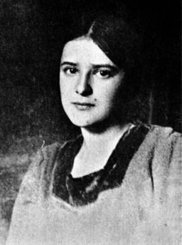Stanisława Przybyszewska facts for kids
Quick facts for kids
Stanisława Przybyszewska
|
|
|---|---|

Stanisława Przybyszewska
|
|
| Born | Stanisława Pająkówna October 1, 1901 Kraków, Austria-Hungary |
| Died | August 15, 1935 (aged 33) Free City of Danzig |
| Pen name | Andrée Lynne |
| Occupation | Playwright, novelist, essayist |
| Language | Polish, German |
| Nationality | Polish |
| Subject | French Revolution |
| Notable works | The Danton Case |
| Relatives | Stanisław Przybyszewski (father), Aniela Pająkówna (mother) |
Stanisława Przybyszewska (Polish pronunciation: [staɲiˈswava pʂɨbɨˈʂɛfska]) was a Polish playwright. She was born on October 1, 1901, and passed away on August 15, 1935. She is mostly known for her plays about the French Revolution.
Her 1929 play, The Danton Case, is very famous. It looks at the conflict between Maximilien Robespierre and Georges Danton. This play is seen as one of the best works about the Revolution. A Polish filmmaker, Andrzej Wajda, even made a movie called Danton in 1983 based on her play.
Contents
Stanisława Przybyszewska's Life Story
Early Life and Education
Stanisława Przybyszewska was born Stanisława Pająkówna in Kraków on October 1, 1901. Her mother was Aniela Pająkówna, an Impressionist painter. Her father was the writer Stanisław Przybyszewski.
From 1902 to 1916, Stanisława lived in different places. She lived in Lviv and traveled across Europe with her mother. They visited cities like Vienna, Munich, and Paris.
In 1912, her mother passed away in Paris. After this, Stanisława lived with guardians. Her parents' friends helped pay for her education at first. Later, her aunt, Helena Barlińska, took care of her.
Between the ages of ten and fifteen, Stanisława went to four different schools. These schools were in France, Switzerland, and Austria. In Austria, she took violin lessons. She also started writing poetry and stories.
From 1916 to 1919, she attended the Teachers Institute for Women in Kraków. She was a very good student. Stanisława was interested in exact sciences, especially mathematics and astronomy. She felt she learned most things by herself. As part of her studies, she taught for a year at an elementary school. She passed her high school exams with honors in 1920.
Meeting Her Father and New Interests
In August 1919, Stanisława met her father as an adult for the first time. She was interested in his ideas at first. However, she later became critical of his works.
In 1920, Stanisława moved to Poznań. She joined a group of artists and writers. She also studied music at a conservatory. She enrolled in a philology course at the Poznań University. There, she studied French and English literature, medieval literature, and history of philosophy. She also learned Spanish, Latin, and Greek.
In 1922, she moved to Warsaw. She worked as a salesgirl in a bookstore. This led to her being briefly held in Poznań. She was released because there was no evidence against her. This experience made her very interested in people who were unfairly imprisoned. She thought about figures like Robespierre and Sacco and Vanzetti.
Marriage and Dedication to Writing
Stanisława married an artist named Jan Panieński. They moved to Gdańsk, where her husband worked as an art teacher. Their marriage was a happy one, even though it did not start with love. However, it was short. In November 1925, her husband died in Paris from a cardiac arrest.
After her husband's death, Stanisława became more isolated. She focused completely on her writing. She rarely left Gdańsk. One time she did leave was for her father's funeral in 1927. There, she met her half-sister, Iwi Bennet. Iwi became one of her closest friends.
Between March 1928 and March 1929, she wrote The Danton Case. She dreamed of becoming a famous European writer, like Joseph Conrad. She spent a lot of time studying German literature. Among Polish writers, she admired Joseph Conrad and Juliusz Kaden-Bandrowski.
Stanisława Przybyszewska's Works and Themes
Stanisława Przybyszewska was very focused on Maximilien Robespierre. She believed he was incredibly smart and could see into the future. She once wrote that she understood Robespierre better than anyone else.
Przybyszewska thought Robespierre had predicted the problems that would come with capitalism. Robespierre was the main character in her two surviving plays. These are The Danton Case (1929) and an earlier play, Thermidor (1925).
Published Works
- Ostatnie noce ventôse’a (The Last Nights of Ventôse). Kraków: Wydawnictwo Literackie, 1958.
- Dramaty. Edited by Roman Taborski. Gdańsk: Wydawnictwo Morskie, 1975. English translation of The Danton Case and Thermidor was published in 1989 by Northwestern University Press as The Danton Case and Thermidor. Two Plays.
- Listy, vol. 1: Grudzień 1913 – wrzesień 1929. Edited by Tomasz Lewandowski. Gdańsk: Wydawnictwo Morskie, 1978.
- Listy, vol. 2: Październik 1929 – listopad 1934. Edited by Tomasz Lewandowski. Gdańsk: Wydawnictwo Morskie, 1983.
- Listy, vol. 3: Grudzień 1927 – październik 1933. Edited by Tomasz Lewandowski. Gdańsk: Wydawnictwo Morskie, 1985.
- “Kobieca twierdza na lodzie,” in Panek, Sylvia, ed., „Jazgot niewieści” i „męskie kasztele”. Z dziejów sporu o literaturę kobiecą w dwudziestoleciu międzywojennym. Poznań: Wydawnictwo Poznańskiego Towarzystwa Przyjaciół Nauk, 2010, 111-21.
- Cyrograf na własnej skórze i inne opowiadania. Gdańsk: Wydawnictwo słowo/obraz terytoria, 2015.
- Asymptoty. Gdańsk: Wydawnictwo słowo/obraz terytoria, 2018.
- Twórczość Gerarda Gasztowta. Gdańsk: Wydawnictwo słowo/obraz terytoria, 2019.
Books about Stanisława Przybyszewska
- Lewandowski, Tomasz. Dramat Intelektu: Biografia literacka Stanisławy Przybyszewskiej. Gdańsk: Wydawnictwo Morskie, 1982.
- Janion, Maria and Stanisław Rosiek, eds. Transgresje, vol. 3: Osoby. Gdańsk: Wydawnictwo Morskie, 1984.
- Kosicka, Jadwiga and Daniel Gerould. A Life of Solitude: Stanisława Przybyszewska, a Biographical Study with Selected Letters. London: Quartet Books, 1986; Evanston: Northwestern University Press, 1989.
- Graczyk, Ewa. Ćma. O Stanisławie Przybyszewskiej. Warszawa: Wydawnictwo Open, 1994.
- Ingdahl, Kazimiera. A Gnostic Tragedy: A Study in Stanislawa Przybyszewska's Aesthetics and Works. Stockholm: Almqvist & Wiksell International, 1997.
See also
 In Spanish: Stanisława Przybyszewska para niños
In Spanish: Stanisława Przybyszewska para niños
- List of Polish people

